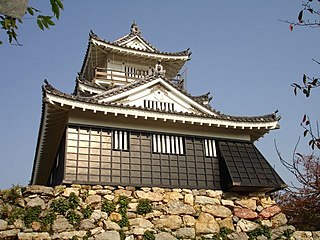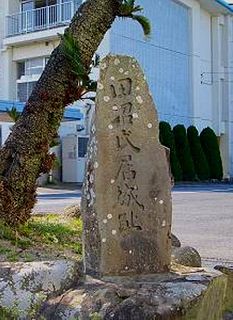 W
WFutamata Castle is a Japanese castle located in Toyoda county of Tōtōmi Province, in what is now part of Tenryū-ku in the city of Hamamatsu, Shizuoka Prefecture, Japan. It was built in the Sengoku period and is noted as the site of the death of Tokugawa Ieyasu's son Matsudaira Nobuyasu in 1579. In 2018, the site was recognized as a National Historic Site by the Japanese government together with adjacent Tobayama Castle .
 W
WHamamatsu Castle is a replica hirayama-style Japanese castle. It was the seat of various fudai daimyō who ruled over Hamamatsu Domain, Tōtōmi Province, in what is now central Hamamatsu, Shizuoka Prefecture, Japan under the Edo period Tokugawa shogunate. It is also called Shusse Castle .
 W
WKakegawa Castle is a hirayama-style Japanese castle. It was the seat of various fudai daimyō clans who ruled over Kakegawa Domain, Tōtōmi Province, in what is now central Kakegawa, Shizuoka Prefecture, Japan.
 W
WKikugawa Fortification ruins are a number of early Sengoku period fortifications located in what is now part of the city of Kikugawa, Shizuoka, Japan. These sites were collectively designed a National Historic Site by the Japanese government in 2004. The National Historic Site designation consists of the sites of the Takada Yashiki ruins (高田大屋敷遺跡) and Yokoji Fortified Residence ruins (横地氏城館跡).
 W
WKōkukuji Castle was a Sengoku period yamashiro-style Japanese castle located in what is now part of the city of Numazu, Shizuoka prefecture. The site has been protected by the central government as a National Historic Site since 1975.
 W
WMitakeCastle was a Sengoku period yamashiro-style Japanese castle located in what is now part of the city of Hamamatsu, Shizuoka in the Tōkai region of Japan. It was a fortress of the local Ii clan, which later rose to prominence under the Edo period Tokugawa shogunate. The site has been protected by the central government as a National Historic Site since 1944.
 W
WNagahama Castle was a Sengoku period flatland-style Japanese castle located in what is now part of the city of Numazu, Shizuoka prefecture. The site has been protected by the central government as a National Historic Site since 1988.
 W
WNumazu Castle was a Japanese castle located in the city of Numazu, Shizuoka Prefecture, Japan. It was a hirayama-jō, a castle built on a plains rather than a hill or mountain. During the Edo period, Numazu castle was home to the Mizuno clan, daimyō of Numazu Domain under the Tokugawa shogunate.
 W
WSagara Castle was a Japanese castle located in what is now the city of Makinohara, central Shizuoka Prefecture, Japan. At the end of the Edo period, Sagara Castle had been degraded to a jin'ya and was home to the Tanuma clan, daimyō of Sagara Domain.
 W
WSunpu Castle was a Japanese castle in Shizuoka City, Shizuoka Prefecture in Japan. The sobriquet of this feudal fortress was the "Castle of the Floating Isle". It was also referred to as Fuchu Castle or Shizuoka Castle .
 W
WSuwahara Castle was a Sengoku period yamashiro-style Japanese castle located in what is now part of the city of Shimada, Shizuoka prefecture, Japan. The site has been protected by the central government as a National Historic Site since 1975.
 W
WTakatenjin Castle was a Sengoku period yamashiro-style Japanese castle located in what is now part of the city of Kakegawa, Shizuoka prefecture. The site has been protected by the central government as a National Historic Site since 1975.
 W
WTanaka Castle is a Japanese castle located in Fujieda, central Shizuoka Prefecture, Japan. At the end of the Edo period, Tanaka Castle was home to a branch of the Honda clan, daimyō of Tanaka Domain.
 W
WYamanaka Castle was a Sengoku period yamajiro-style Japanese castle, built by the Odawara Hōjō clan in Tagata District, Izu Province, in what is now eastern Mishima, Shizuoka Prefecture, Japan. The site has been protected by the central government as a National Historic Site since 1988.
 W
WYokosuka Castle is a Japanese castle located in Ōsuka in the southern part of what is now the city of Kakegawa, Shizuoka, Japan. It was built in the Sengoku period and was the capital of Yokosuka Domain during the Tokugawa shogunate of Edo period Japan. In 1981, the site was recognized as a National Historic Site by the Japanese government.